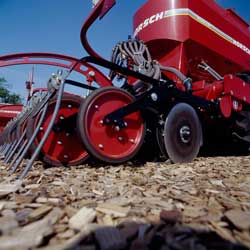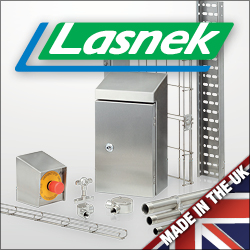
Posted to News on 21st Nov 2010, 12:44
Causes of bearing failure in agricultural equipment
In this article, Schaeffler discusses the various modes of premature bearing failure on agricultural machinery and recommends way to avoid them.

Rolling bearings are critical components in agricultural machinery. This also means that premature failures can result in costly, unforeseen breakdowns and repairs. In order to avoid these, the various failure modes need to be understood so that appropriate action can be taken.
Invariably, machine components will have to cope with a variety of conditions, including high humidity levels, dirt and shock loads. Even the best bearings will eventually reach the end of their design life, so it is important to design bearings arrangements to ensure that the removal and mounting process is quick and easy. And if a bearing needs to be replaced, consider the whole-life costs, rather than just the purchase price, as a low-cost bearing is likely to require replacement sooner and may result in a further costly breakdown.
Counterfeits and bearing damage
The use of counterfeit bearings on high-value capital machinery will almost certainly endanger the operating reliability of a machine, since these bearings will have been manufactured to inferior quality standards. While the offer price for inferior or counterfeit bearings may initially look attractive, buyers must ask themselves what the potential 'hidden' costs are in terms of product liability and credibility with their customers if the product turns out to be counterfeit and things inevitably start to go wrong. Buyers therefore need to take into account the cost of any machine downtime if the bearings fail early.
Why do inferior or counterfeit bearings fail?
Low-cost, inferior or counterfeit bearings are normally manufactured from inferior-grade materials. The bearings often fail early due to inadequate or incorrect lubricants being used, including a failure to machine lubrication grooves into the outer raceways. Other inferior bearings may suffer from poor sealing, non-hardened or poorly ground raceways, poor cage designs, and poor corrosion protection. Further problems include inappropriate packaging of the bearing or incorrect storage prior to use.
The message here is always buy from an authorised distributor or direct from a reputable manufacturer, otherwise the risks are too high.
There are many ways in which bearing failures can occur. Here are some of the most common signs of bearing damage:
Flaking
Flaking (or spalling) occurs as a result of fatigue at the contact points of the rolling elements and raceways, usually when the bearing has reached the end of its normal life. Classic fatigue begins with subsurface fissures that progress to the surface and cause material fragments to break loose. Once started, the problem increases because the loose fragments are distributed around the raceway and the bearing becomes unserviceable, with increasing vibration and noise, as well as possible eventual fracture.
Premature fatigue can be caused by excessive loads, inadequate lubrication, improper handling or assembly, poor installation design (incorrect shaft and housing tolerance limits), misalignment, contamination or a reduction in hardness at high temperatures.
Selection of appropriate mounting based on the operating conditions, adequate sealing, accurate installation, the use of proper fitting techniques, lubrication and maintenance, should help the bearing to achieve its design fatigue life.
Wear
Wear is the loss of material from sliding or rolling contacting surfaces due to abrasion. Normally this is caused by inadequate lubrication, which produces a shiny worn surface, or the ingress of small abrasive particles (dull, worn areas). Inadequate lubrication can also cause discoloration due to overheating.
When wear does occur, engineers should ensure that the lubricant is of the correct type, that it is clean and that a sufficient quantity is reaching the bearings. Sealing should also be improved where possible.
Smearing
Smearing (or skidding) is caused by inadequate lubrication and can occur at the contact surfaces between rollers and their guide ribs. This usually occurs if the rolling elements are subjected to severe acceleration on their entry into the load zone, as well as in situations where the bearing load is too light with respect to operating speed.
Improved lubrication and careful selection of the bearing to suit the operating conditions should prevent the occurrence of smearing. Bearing rings should also be fitted with sufficient interference.
Seizure
Seizure is caused by extreme smearing, leading to friction welding of bearing components. As this is due to metal-to-metal contact caused by failure of the oil film, adequate lubrication under all operating conditions will normally prevent this occurring.
Cage damage
Distortion of bearing cages can be caused by improper mounting techniques. Inadequate lubrication or contamination by abrasive particles can also result in wear of the pockets and to the inner and outer diameters. Cage fractures are primarily caused by vibration, excessive running speeds or acceleration, seizure, high temperatures (for plastic cages) and damage during mounting.
These failures can be reduced by employing the appropriate fitting techniques, adequate lubrication and sealing, as well as matching of the cage type to the operating conditions (speed and temperature).
Corrosion
Corrosion (rust) can be caused by: poor storage conditions or incorrect packaging; insufficient rust inhibitor; penetration by water, acids and other aggressive media; or by incorrect handling.
Measures should be taken to prevent rusting while the bearings are in storage and to improve the sealing performance. Lubricating oil should be inspected periodically and tested for signs of contaminants.
Preventative measures
We have already highlighted some preventative measures above, but it should also be noted that reputable bearing manufacturers now offer a wide variety of maintenance-free bearings and seals for agricultural machinery, designed specifically to increase service and maintenance intervals, thereby helping to minimise machine downtime and MRO (maintenance/repair/overhaul) costs.
These bearings are available in various configurations, including needle, cylindrical, spherical and tapered roller bearings. Housed bearing units are also common, as are angular-contact and radial-insert ball bearings. Special, custom-designed bearings for specific agricultural machinery can also be provided.
Schaeffler's INA and FAG brands offer a wide choice of bearings for applications in gears, power transmission systems and axles. Bearings can be manufactured in premium quality X-life standard, with improved surface and geometrical accuracies, resulting in increased performance, improved reliability and longer bearing life.
For more information about Schaeffler's range of rolling bearings for agricultural machinery, call Schaeffler UK's Marketing Department on +44 (0)121 313 5870 or email [email protected].
Want the latest machine building news straight to your inbox? Become a MachineBuilding member for free today >>



















